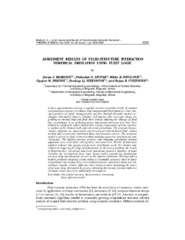Приказ основних података о документу
Assessment results of fluid-structure interaction numerical simulation using fuzzy logic
| dc.creator | Marković, Zoran J. | |
| dc.creator | Stupar, Slobodan | |
| dc.creator | Dinulović, Mirko | |
| dc.creator | Peković, Ognjen | |
| dc.creator | Stefanović, Predrag Lj. | |
| dc.creator | Cvetinović, Dejan | |
| dc.date.accessioned | 2022-09-19T17:52:27Z | |
| dc.date.available | 2022-09-19T17:52:27Z | |
| dc.date.issued | 2016 | |
| dc.identifier.issn | 0354-9836 | |
| dc.identifier.uri | https://machinery.mas.bg.ac.rs/handle/123456789/2304 | |
| dc.description.abstract | A fuzzy approximation concept is applied in order to predict results of coupled computational structure mechanics and computational fluid dynamics while solving a problem of steady incompressible gas flow through thermally loaded rectangular thin-walled channel. Channel wall deforms into wave-type shapes depending on thermal load and fluid inlet velocity inducing the changes of fluid flow accordingly. A set of fluid-structure interaction numerical tests have been defined by varying the values of fluid inlet velocity, temperature of inner and outer surface of the channel wall, and numerical grid density. The unsteady Navier-Stokes equations are numerically solved using an element-based finite volume method and second order backward Euler discretization scheme. The structural model is solved by finite element method including geometric and material non-linearities. The implicit two-way iterative code coupling, partitioned solution approach, were used while solving these numerical tests. Results of numerical analysis indicate that gravity and pressure distribution inside the channel contributes to triggering the shape of deformation. In the inverse problem, the results of fluid-structure interaction numerical simulations formed a database of input variables for development fuzzy logic based models considering downstream pressure drop and maximum stresses as the objective functions. Developed fuzzy models predicted targeting results within a reasonable accuracy limit at lower computation cost compared to series of fluid-structure interaction numerical calculations. Smaller relative difference were obtained when calculating the values of pressure drop then maximal stresses indicating that transfer function influence on output values have to be additionally investigated. | en |
| dc.publisher | Univerzitet u Beogradu - Institut za nuklearne nauke Vinča, Beograd | |
| dc.relation | Public Enterprise Electric Power Industry of Serbia, Belgrade, Serbia | |
| dc.relation | info:eu-repo/grantAgreement/MESTD/Integrated and Interdisciplinary Research (IIR or III)/42010/RS// | |
| dc.relation | info:eu-repo/grantAgreement/MESTD/Technological Development (TD or TR)/33050/RS// | |
| dc.relation | info:eu-repo/grantAgreement/MESTD/Technological Development (TD or TR)/35035/RS// | |
| dc.rights | openAccess | |
| dc.rights.uri | https://creativecommons.org/licenses/by-nc-nd/4.0/ | |
| dc.source | Thermal Science | |
| dc.subject | thin-walled structure | en |
| dc.subject | fuzzy inference model | en |
| dc.subject | fluid-structure interaction | en |
| dc.title | Assessment results of fluid-structure interaction numerical simulation using fuzzy logic | en |
| dc.type | article | |
| dc.rights.license | BY-NC-ND | |
| dc.citation.epage | S250 | |
| dc.citation.other | 20: S235-S250 | |
| dc.citation.rank | M23 | |
| dc.citation.spage | S235 | |
| dc.citation.volume | 20 | |
| dc.identifier.doi | 10.2298/TSCI160111083M | |
| dc.identifier.fulltext | http://machinery.mas.bg.ac.rs/bitstream/id/1056/2301.pdf | |
| dc.identifier.scopus | 2-s2.0-85121898213 | |
| dc.identifier.wos | 000378584200021 | |
| dc.type.version | publishedVersion |


